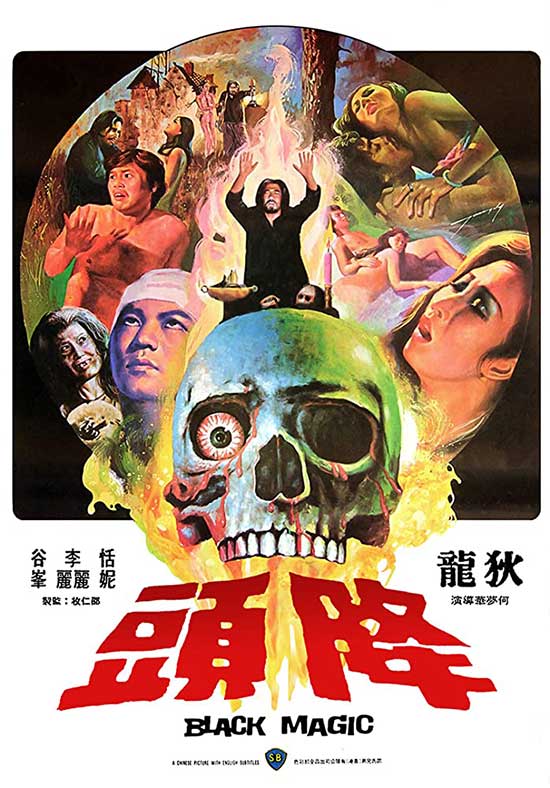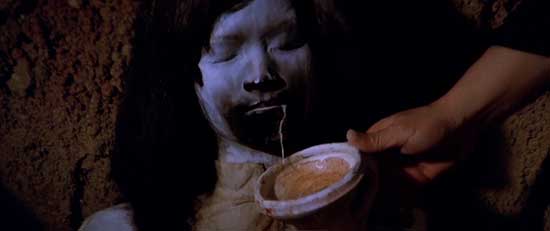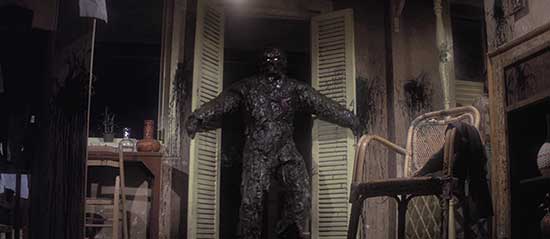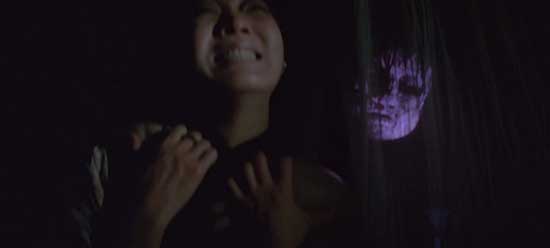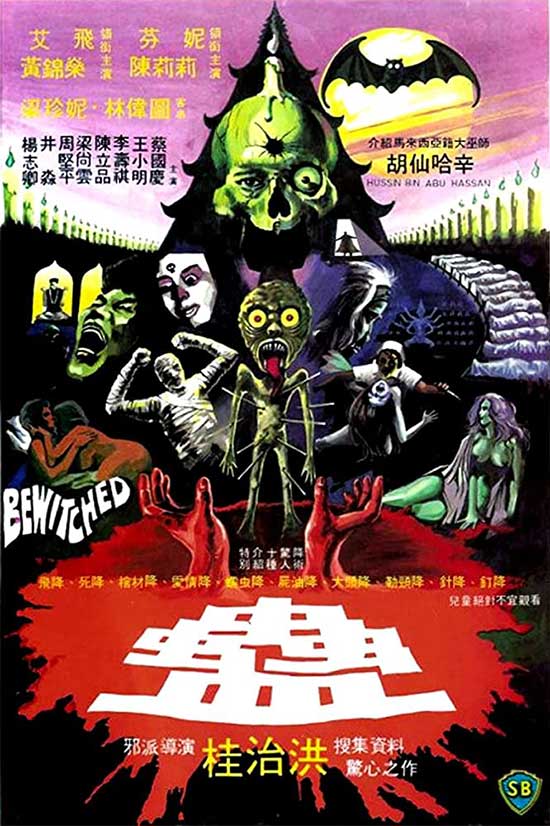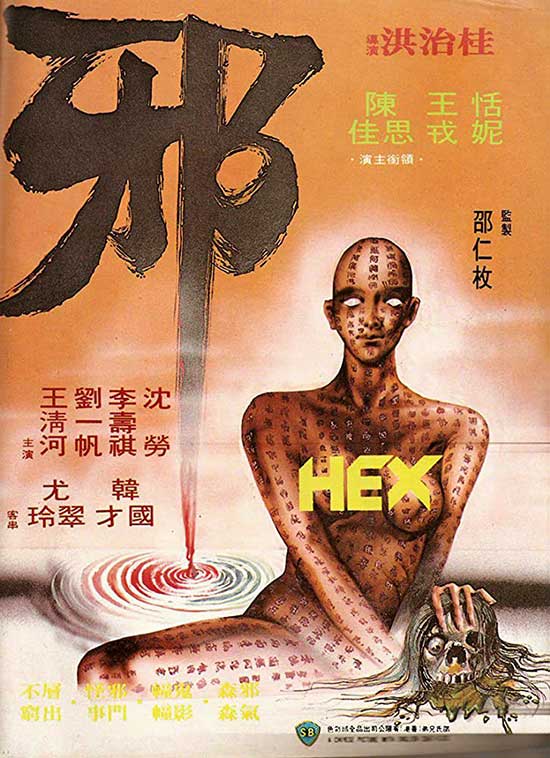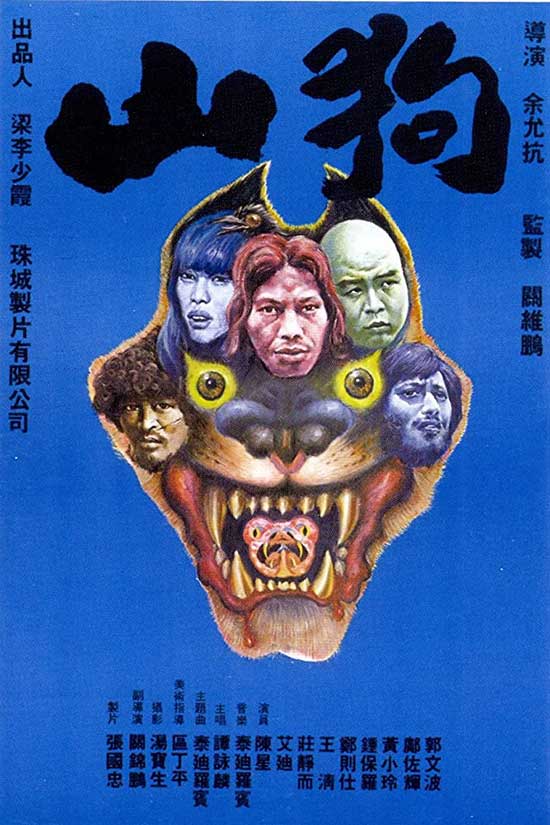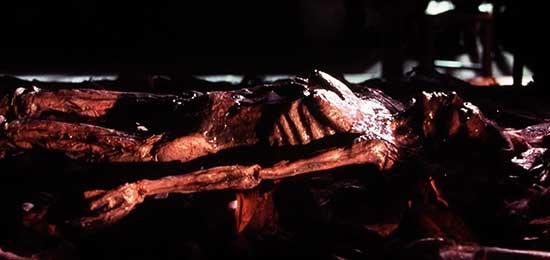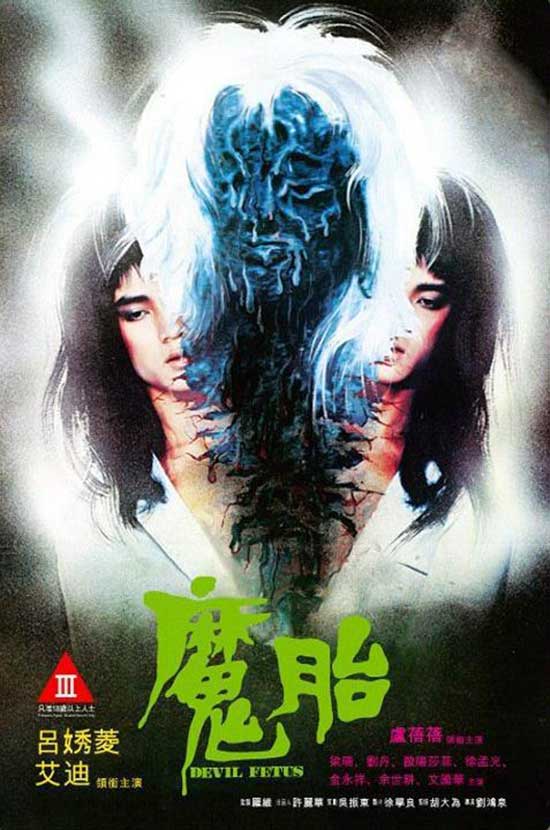I am, and have always been, a great fan of satanic, occult and black magic themed horror. From The Devil Rides Out (1968) to Hereditary (2018), there’s just something about a story involving the dark forces that appeals to my specific penchant in horror. Crazy death cults, Satanic conspiracies, ritual sacrifice and evil spells being cast on people; I welcome them all as warmly as I would an old friend. In recent years, I have directed my never-ending search within the genre more towards the east, more specifically Hong Kong, and the wonderous treasure trove of black magic cinema it has to offer. I do not think I can possibly overstate how exciting, fantastic and completely insane this little sub-genre of HK-horror is. From the mid 1970’s to the mid 1980’s this very peculiar take on occult horror dominated the HK horror scene, fully embracing the dark arts as well as the staples of exploitation cinema: copious amounts of violence, extravagant, gross-out special effects and of course, abundance of nudity.
As is usually the case with any kind of large cinematic trend, black magic films were produced en masse and with dizzying speed. With everyone trying to profit from the same craze, it is not surprising than the same themes and plot devices are widely recycled throughout the genre. The basics of most the HK black magic cinema are as follows: Scary black magic practitioner (most probably foreign, usually Southeast Asian) whose services are either bought by someone wanting some evil magic done or who has been offended or betrayed by someone and is now taking revenge.
To this you add a dashing leading man and his virginal lady love (or sometimes just a friend, if he happens to be in the friend zone), black magic rituals, often featuring sex with corpses or something equally as pleasing, love spells that go wrong, someone vomiting maggots or worms (without fail), a battle between good and evil including lasers, and someone getting raped by either a ghost or a demon (potentially resulting in a pregnancy). If you can get passed the rampant xenophobia and the occasional animal sacrifice, all these elements combined make up some very enjoyable viewing and sub-genre well worth exploring. So, get ready for incredible evil, more maggots you can count and some serious power perms as we dive into the wonderful world of Hong Kong black magic cinema.
The kick-starter for the black magic boom is often cited as being the Shaw Studio’s 1975 entry Black Magic (Jiang tou). Directed by Ho Meng Hua, it tells a tale of a young man Xu Nuo (Ti Lung) whose lack of interest in trampy but obscenely wealthy widow Mrs. Zhou (Tanny Tien Ni) causes her to seek a help of a forest dwelling sorcerer and his powerful love magic. In this mix are also Xu Nuo’s fiancée Chu-ying (Lily Li), whose suspicions are raised after Xu Nuo runs off with Mrs. Zhuo within hours of the two lovebirds tying the knot, a local gold digger Liang Chia-chieh (Lo Lieh) who is desperately trying to catch the attention of the wealthy Mrs. Zhou, albeit with very little success, and Master Fu Yong (Ku Wen-chung), a kind white magic practitioner who will come to the aid the of the hapless lovers. Compared to some of the later instalments of the genre, Black Magic is not the most graphic in the special effect department and majority of the films running time is taken up by the soap opera style love triangle (or is it a square? Perhaps even a pentagon).
It does offer some mild thrills in a form of severed heads, maggots crawling under people’s skin and fantastically goofy moments of bizarre black magic rituals that include smearing rice into women’s nether regions and milking their breasts for magical purposes. The soundtrack consists of what can only be described as 70’s elevator music, cementing the whole soap opera atmosphere even further. Ho followed up the success of Black Magic with Black Magic 2 the following year. With no connection to the plot of the first film, but again starring Ti Lung, Tanny Tien Ni, Lily Li and Lieh Lo, the story takes place in Singapore where an evil black magic practitioner (Lieh Lo) is raising an army of the undead, leaving a trio of doctors to figure out what is going on and just what the heck happened to their exotic getaway. More xenophobia and spells containing breast milk ensue, alongside special effects with the gross out factor kicked up a notch. Super fun viewing for all…well, some of the family.
In 1976 Ho Meng Hua brought to the screen another kind of magical terror, in the form of The Oily Maniac (You gui zi). In it a young, mild mannered man by the name of Shen Yuan (Danny Lee) is transformed to an oil covered, revenge seeking monster, as he takes on the evil doers of the local area. With a help of an old Malayan spell, the otherwise crippled Shen rampages around delivering justice to rapist, unethical doctors and blackmailers alike. The bodysuit used to create this greasy avenger is a sight to see and its enraged howling (the same foley used over and over again) something that you will not forget in a hurry. Considering the clumsiness of Shen’s alter-ego it’s amazing that he ever gets any actual killing done, but luckily, he is also able to transform himself into a puddle of oil and thus slither under doors or use plumbing as points of entry. Pretty handy is you ask me. The focus of the film may not be on magical rituals or a battle between good and evil, but this greasy monstrosity definitely deserves a mention in the context of black magic cinema, if for nothing else than its goofy special effects.
In 1980 The Shaw studios continued its journey in the dark side with Hex (Xie); a Shaw brothers take on Henri-Georges Clouzot’s 1955 classic Les Diaboliques. Directed by Chih-Hung Kuei, it’s a story of deceit, murder and of course, a little bit of black magic. In it, a young wife (again, the lovely Tanny Tien Ni) semi accidently murders her cruel husband, only to have him return from beyond the grave to continue torturing her. But all is not quite as it seems in this tale of double cross and those thought as dead might be very much alive and ghosts thought as fake, might end up being more real than first realised.
Hex is not by any mean a typical example of the genre. It does not revel in gross out special effects and the supernatural elements of the story only really make an appearance at the very end, but boy oh boy what an ending it is! If you only going to see one naked exorcism scene in your life, make it this one. While this vividly psychedelic dance recital differs wildly from the rest of the film, it is still an incredibly enjoyable little snippet of completely bonkers supernatural weirdness. Hex was followed with two sequels: Hex vs. Witchcraft (Che dau che , 1980) and Hex After Hex (Xie wan zai xie , 1982), both of which bare no connection to the original film, but featuring things like marriages between humans and ghost, possession and violence, have more solid footing in the black magic genre.
Kuei stayed with the genre for a few more films after the Hex trilogy, directing Bewitched (Gu, 1981), Corpse Mania (1981. More of a HK giallo than a black magic film, but with its abundance of necrophilia, it does fit into the same slot of exploitation quite nicely) and one of the craziest black magic romps of the decade, The Boxer’s Omen (Mo, 1982). In it a Hong Kong boxer travels to Thailand in order to avenge his brother, crippled while fighting a corrupt Thai boxer. A simple revenge mission this ain’t, and he soon gets entangled in a fight between good and evil in form of a Buddhist ghost and a black magic sorcerer. With the help of local Buddhist monks, he takes on the forces of evil in what can only be described as some of the most off the wall fight scenes of the genre. The Boxer’s Omen lacks somewhat in the story department and does not offer anything as cohesive as Hex or Black Magic. Instead the focus is firmly on the wild and wonderful special effects that dominate the centre stage in the film’s numerous fight scenes. There are demonic bats, snapping crocodile skulls, felt spiders that will inject you with poison and caterpillars squirming their way into ears and noses. Some might find the endless parade of wacky weirdness a bit tiresome after a while, and even I must admit that some of the action sequences could do with a bit of editing. Nonetheless, if you just forget having a followable plot and watch it purely for the absolutely madness that it has to offer, The Boxer’s Omen is a damn fine, and more importantly fun, example of black magic exploitation.
1982 brought the audiences more than one outlandish installment of the genre, as the director Chin Lee also blessed the world with his film Kung Fu from Beyond the Grave (Yin ji). In this horror-comedy mashup a young man by the name of Chun Sing receives a visit from his dead father during the Hungry Ghost Festival. After getting kicked in the head by his son (luckily he’s already dead) and explaining that he has saved up money while in hell in order to bribe whoever it is that you bribe to get out of there, he proceeds to inform Sing that he was murdered by an evil priest in command of the dark forces and as a good son, he should go and take revenge. Rather than questioning why his dear old dad has been sent to hell or the fact that you still must work to earn money in the afterlife, Sing’s take home from this conversation is “What’s that? You mean they also take bribes in hell?”. Nevertheless, as a dutiful son he does as his father asks and soon, he finds himself battling evil forces with an aid of a magical spell book, some friendly hopping vampires and a brothel full of working girls. There is a lot to unpack here and I do not want to reveal all the twists and turns of this cinematic masterpiece, but let’s just say that if you are prepared for a special cameo appearance by Count Dracula, you will not be too disappointed.
Dennis Yu, the director of the CAT III rape-revenge tale The Beasts (San gau, 1980) also tried his hand in the darker side of magic with his 1981 offering The Imp (Hung bong). Unlike the somewhat ambiguous title might suggest, this tale is not ruled by mischievous miniature spirits, but some very serious supernatural threats in form of violent ghosts and deadly curses. In it a young night watchman Keung has just got a new job as a security guard for a half empty commercial building. With a pregnant wife at home, Keung is certain that his rotten luck is about to change, only to find his colleagues starting drop dead all around him. This concerns him enough to go a consult a local Taoist priest, who informs him that not only is his new place of work riddled with spirits, they are now after Keung’s unborn child. Worrying news indeed! Yu has managed to pack this little gem full of great atmosphere as well as some genuinely eerie moments. In true HK exploitation style, there is little bit of silly slapstick humour thrown into the mix as well, but the overall ambience is quite dark, leaving the viewer to deal with a very bleak ending. A great watch not only amongst the black magic but also ghost/haunting genre.
The genre really seemed to hit its peak in 1983 with numerous titles exploiting the dark arts coming our one after another. Kuen Yeung’s Seeding of a Ghost (Zhong gui) takes the familiar story arc of an innocent individual getting attacked/cursed/possessed by an evil sorcerer to slightly different waters, instead exploring black magic as means of revenge. A Hong Kong taxi driver Chou Tang (the star of The Boxer’s Omen, Phillip Ko) helps out a local sorcerer getting chased by some angry villagers, and what do you know, this chance encounter soon comes handy, as he needs to take revenge on couple of thugs who rape and kill his wife. With the aid of his dead wife’s corpse, revenge is soon in motion, worm vomit and all. The evil doers get what’s coming to them in form of terrifying hallucinations, exploding toilets and wives that get possessed and rape (?) them with a giant matchsticks, clearly and conclusively demonstrating that even if you escape the earthly justice of local authorities, crime does not pay. Where Seeding of a Ghost differs from many of the other genre offerings is of course the fact that the sorcerer in this story is not actually evil, despite practicing the dark arts. In fact, he even gives Tang a fair warning about the dangers of such magic, before commencing the mission of revenge. With even the main hero suffering the (side) effects of magical revenge, in this tale of vengeance the viewer is the real (and only) winner. With fantastic special effects and a gruesome finale that gives both Alien (1979) and The Thing (1982) a run for their money, Seeding of a Ghost is one of the best of the best.
In Hung-Chuen Lau’s Devil Fetus (Mo tai, 1983) things get very rapey, very fast when a clueless wife Suk-Jing buys an ancient jade vase from the market and the demon residing within pops out to impregnate her. When her unsuspecting husband Ji-Wan returns from a business trip and finds his wife in bed with a swamp monster, he swiftly breaks the vase, only to get cursed and killed in the process. Poor Suk-Jing has no time to mourn her husband though, as she too soon dies in a freak accident involving her husband’s ghost and the family cat. The memorial plaques are sealed with magical talismans to prevent the restless ghosts and the possible demon baby from hassling the living and everyone lives happily ever after.
Or do they? We Jump 12 years head and Ji-Wan and Sik-Jing’s nephews Ken and Wai are all grown up, still living at the same address. Enter Jo-Jo, a family friend from Singapore, visiting the family for a holiday. After being in the house for mere hours, she goes and stumbles around the memorial room disturbing the talismans, letting all hell break loose. Stupid, clumsy Jo-Jo! Over the years the family has upgraded the pesky cat to a friendly German Shepard, but as you might guess, having a large dog in a haunted household is not such a great idea, and Bobby the dog is the first one to fall victim to the forces plaguing this family. After attacking Ken, Bobby is quickly put down and buried in the backyard, but not before he manages to shoot cursed lasers from his eyes at Wai and infect him with this nettlesome curse. Wai then amps up the creep factor by nearly drowning Jo-Jo and raping the family housekeeper. At this point grandma Cheng figures that something isn’t right and gets some Taoist professionals in to deal with the problem. More possessed nonsense, lasers, worm vomit and beastly sex ensue before this curse is lifted, making for a very entertaining hour and a half.
Devil Fetus’ success was clearly in the mind of Moon-Tong Lau when he wrote and directed The Rape After, also known as Devil Fetus 2: The Rape After (Yin Zhong, 1984), despite the fact that it has next to no bearing to Devil Fetus. While the stories are not linked, they do share similar themes a.k.a. statues that come alive and rape women. In it a photographer Mo Hsien Sheng (Melvin Wong) is in the habit of stealing items from his shoots. One such theft ends up giving him more than he bargained for when the spirit it houses comes alive and rapes and impregnates his model, Shu Ya (Wai Man Chun). Being the charming individual that he is, Mo quickly takes the Shu Ya to the nearest abortion clinic and despite her protestations, demands the doctor to carry on with the deed. But as this is no normal pregnancy, nor is the father a mere mortal, things do not go quite to plan, and Shu Ya escapes the clinic with her demonic spawn still on board.
Mo goes on with his life like nothing ever happened only to be called up to lend a hand when Shu Ya goes into labour. On their way to the hospital Mo crashes the car and not being able to free Shu Ya (not that he tries that hard), she and her baby are killed when the car catches on fire. Lucky break for Mo? Think again. These kinds of forces don’t simply stop because they die in a fire and soon Mo’s life spirals into a vortex of supernatural madness. Somewhat ironically, The Rape After actually has more devil foetuses than Devil Fetus, but unfortunately it does not quite manage to keep up the same atmosphere as its predecessor. The plot drags quite significantly around midway through, leaving you wondering whether this tale is ever going to go anywhere. Rest assured it does in the end, but it does take just a tad too long to do so.
So, what can we learn from all this? First and foremost, don’t travel to South-East Asia, or at very least make sure you do not piss off any local sorcerers. However, if you do, make haste and find either a Taoist priest, Buddhist monk or a friendly white witch to help you. If you see rectangular yellow pieces of paper with red writing on them, do NOT touch them. They are magical talismans and removing one, will likely get you haunted, possessed or killed. Or all three. Think twice before buying antique vases or statues and for god’s sake, don’t steal one. Sentient oil spills are likely to be monsters out for revenge and sex with a demon results in a very difficult birthing experience.
The films listed above are just a starting point and believe me when I tell you there is plenty more to explore when it comes to Hong Kong black magic cinema. It’s not without its faults. As discussed before, xenophobia and unfortunately real live animal cruelty (if this is something that bothers you in particular, stay away from titles like Centipede Horror and Red Spells Spells Red) do have a firm place in this sub-genre. Nevertheless, it is a real gem of Hong Kong horror history offering everything that great exploitation cinema should and something that every self-respecting exploitation fan should explore.
Further viewing:
-Spirit of the Raped (Suo Ming, 1976)
-Bewitched (Gu, 1981)
-Hell Has No Boundry (Mo jie, 1982)
–Centipede horror (Wu gong zhou, 1982)
-Red Spells Spells Red (Gong gui zai, 1983)
-Black Magic With Buddha (Nao mo, 1983)
 Horror News | HNN Official Site | Horror Movies,Trailers, Reviews
Horror News | HNN Official Site | Horror Movies,Trailers, Reviews
